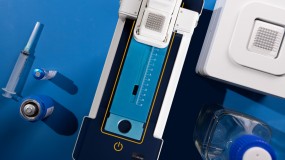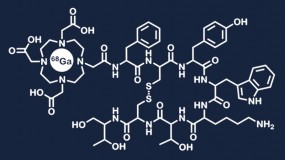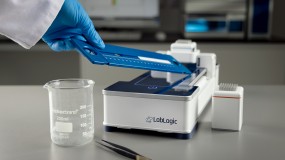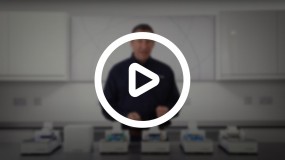The innovative, flexible and compliant radio-TLC scanner
LabLogic’s radio-TLC Scanner, the innovative Scan-RAM, is designed to meet the ever increasing demands of the modern laboratory. Versatile and compact, the instrument is fully controlled by market leading radio chromatography package Laura for PET, providing accurate and reproducible results for radiochemical purity measurements.
Innovative features designed for PET/SPECT
The Scan-RAM has a range of innovative features including a motorised detector, unique TLC plate support beds and an adjustable collimator.
Fully compliant and compatible with Laura for PET
As with all LabLogic products the Scan-RAM has been designed to exceed regulatory requirements. Features such as a single power button, coupled with the industry standard Laura for PET software offers users the ultimate in compliance.
More than a radio-TLC scanner and analyser
The Scan-RAM is available not only as a radio-TLC scanner and analyser, but also as a dual radio-TLC and radio-HPLC instrument, uniquely combining a radio-TLC scanner and a radio-HPLC detector. They both work independently yet simultaneously and offer users the ultimate flexibility whilst saving valuable laboratory space.
With a wide range of detectors suitable for both low and high levels of radioactivity, the Scan-RAM is the ideal radio-TLC scanner and analyser.
Scan-RAM Duo Detector
The 'TLC only' Scan-RAM can be supplied in two configurations, the first holds a single detector - this is interchangeable with other detectors should your work evolve with time. The second model houses two detectors, with Laura selecting the most appropriate detector for each product method - ideal for groups working with PET and SPECT samples in the same department.
Find out more today, request a demo, or get a quote by contacting the LabLogic team.
Adjustable Collimator
The adjustable height of the collimator combined with different aperture slits, offers users the ultimate flexibility whether working with high or low levels of radioactivity.
A Range of Detectors
The Scan-RAM radio TLC scanner and analyzer is suitable for PET, SPECT and Alpha radionuclides across a range of radioactivity levels.
The Scan-RAM now also offers the ability to have two detectors in the lead collimator for radio-TLC measurements of PET, SPECT, and high-energy beta radionuclides within the same instrument.
Motorised Detector
The detector’s smooth motor operation eliminates the need to tape the TLC plate to the scanning bed, significantly reducing finger dose and ensuring positional reproducibility.
The detector does not require any operational tolerance, the space taken up by the Scan-RAM is the same as the footprint of the instrument.
Engraved Ruler
Facilitates confirmation of the TLC strip size and allows users to record this information in Laura for PET, thus optimising analysis time.
Intelligent Front End Display
Users are able to view instrument parameters and performance of the radio TLC scanner at a glance.
Single Power Button
The single power button and full software control allows only users with an appropriate access level to make changes to the operating parameters of the radio TLC scanner and analyser. A full audit trail of these changes is recorded.
TLC Plate Beds
The Scan-RAM is supplied with TLC plate support beds which are easily cleaned, conveniently stored and ideal for lowering finger exposure. Accommodating any size TLC strip up to 5 x 20 cm.
USB Interface
USB interface which provides; instrument control, HV supply, data transfer and electronics power supply.
Built-in Analog to Digital Converter
This Dual Scan-RAM feature converts analog signals from other detectors such as UV, ECD, etc., into digital for use within Laura for PET. Bringing all signals into one place.
Bespoke Lead Shielding
In order to minimise background interference LabLogic provides a range of lead shielding to meet different requirements.
What is the Scan-RAM operating tolerance?
Because the detector sweeps the scanning bed, there is no operating tolerance requirement, and as such the required operating space is the same as the footprint of the instrument
Why do I need the TLC support beds?
These beds have been provided for your own safety and to minimise finger dose exposure.
Can I clean the TLC support beds?
Yes you can clean them with standard cleaning solutions.
Where do I store my TLC support beds?
The TLC support beds are stored underneath the instrument, in the built-in racks provided.
Can I use the same Scan-RAM for different radionuclides?
Yes you can. The Scan-RAM is available with a range of interchangeable detectors for different radionuclides and different levels of radioactivity.
What is the difference between Dual and Single Scan-RAM?
The Dual Scan-RAM is two instruments in one. It is a radio-TLC scanner and radio-HPLC detector. This instrument is ideal for customers who have to analyse their samples by both methods as it saves on capital expenditure and operating space.
The Single Scan-RAM, is radio-TLC scanner only that is used for radio-TLC analysis.
What is the size of the crystal in your detectors?
We offer a range of different crystal sizes to meet different requirements. If you know what radionuclides you will work with, LabLogic will furnish you with information on the recommended detector and crystal size.
What happens if a component stops working In the Dual Scan-RAM?
The electronics in the Dual Scan-RAM are separate for radio-TLC and radio-HPLC.
In the unlikely event that one set of electronics develops a fault, the use of the radio-HPLC, or radio-TLC depending upon what happens, would not be affected.
Do you have to sellotape TLC strips to the scanning bed?
No you do not. The scanning bed is stationary and it is the detector that sweeps the bed.
Also, your TLC strips are held by the TLC support beds which are locked in place by soft buttons.
How do I change the operating parameters?
All operating parameters are changed through Laura for PET software where a full audit trail of the changes is recorded.
Scan-RAM radio-TLC scanner existing customers
Click on the tabs below to find out more about some of our customers and how they are using the Scan-RAM in their facilities.
CHU Grenoble Alpes, France
Grenoble University Hospital (CHU Grenoble Alpes) and Grenoble Alpes University (UGA) have used LabLogic’s instruments to submit an Investigational Medicinal Product Dossier (IMPD) for a new radiopharmaceutical labelled with Lutetium-177. A validation dossier for Analytical Methods has been produced to assess the radiochemical purity of 177Lu-PSMA-1 using the Flow-RAM for Radio-High Performance Liquid Chromatography (r-HPLC) and Scan-RAM for Radio-Thin Layer Chromatography (r-TLC).
READ MORE
Edinburgh Imaging Facilities, UK
The Scan-RAM is being used at Edinburgh Imaging Facility’s radiochemistry unit at the University of Edinburgh, which houses a cyclotron with supporting radiochemistry suites to produce research PET radiotracers including F-18, C-11, and O-15. This allows EIF to conduct PET imaging experiments, develop fully translational tracers, and adopt existing radiotracers to GMP standards for clinical studies.
EIF has four imaging facilities, including ones at the Queen’s Medical Research Institute, Royal Infirmary of Edinburgh, and the Royal (Dick) School of Veterinary Studies for the imaging of large and small animals.
LEARN MORE
Contrast Media and Molecular Imaging, Greece
The Scan-RAM has been used in a research paper published by an international team, who's study investigated coated iron oxide nanoparticles labelled with the positron emitter Gallium-68, as potential PET and MR imaging agents. The Scan-RAM was used as part of the study to determine the radiolabelling yield and purity.
Abstract: The aim of this study was to develop a dual-modality PET/MR imaging probe by radiolabeling iron oxide magnetic nanoparticles (IONPs), surface functionalized with water soluble stabilizer 2,3-dicarboxypropane-1,1-diphosphonic acid (DPD), with the positron emitter Gallium-68.
Read more about the study here.
Clinica Universitaria de Madrid, Spain
The university invested a Scan-RAM unit and Laura for PET for their new facility. Read more about the sale here.
Memorial Sloan Kettering Cancer Center, USA
One of the largest cancer centres in the world chose LabLogic for a comprehensive list of PET laboratory products including three Scan-RAM's, two Flow-RAM's and one Posi-RAM for preclinical research and development. Read more here.
New Cross Hospital, UK
The hospital in Wolverhampton has been using LabLogic's Scan-RAM for a number of years now and it has proven to be an indispensable instrument. The hospital radiopharmacy team use the instrument with a 1' NaI detector for RCP (Radiochemical Purity) testing of Tc-99m labelled radiopharmaceuticals. Read what Wendy Sanders, Production Manager, had to say about the instrument here.
ÚJV Řež, Czech Republic
The PET Centre, part of ÚJV Řež, purchased a Scan-RAM as a replacement for a TLC-scanner supplied ten years ago by a rival manufacturer. Read the good feedback about the Scan-RAM from the centre here.
University of Illinois, USA
The Scan-RAM was purchased for the molecular imaging laboratory in the Biomedical Imaging Centre at the Beckman Institute of Advanced Science and Technology. The facility is designed for the development, synthesis, bio-conjugation and testing of multimodal targeted agents in order to monitor biological processes within living animals. Read more about the university and the sale here.
Alliance Medical, UK
Alliance Medical is one of Europe’s leading independent providers of medical imaging services. With more than 25 years of experience, they have been supplying high-quality and cost-effective imaging for their customers and providing medical imaging services for more than 400,000 patients in the UK and across Europe.
Tom Latham, Quality Control Supervisor for AMR in Preston
“Having the same pieces of equipment installed and validated on multiple sites permits flexibility and continuity for us by enabling the analytical methods, procedures and training to be applied across all sites.”
Vivien Cliff, Senior Quality Control Radiochemist for AMR in Keele
“We have used the Scan-RAM since 2014 for a few batches a week, the system is easy to use (both software and hardware) and presents very few technical issues to users on a day to day basis.”
Alessandra Contini, Quality Control Radiochemist for AMR in Sutton
“The best part was that it was in one package with hardware, software and validation all included.”
Read more!








